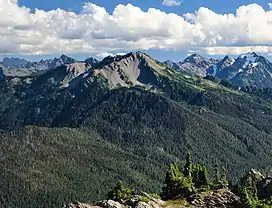Mount Wilder
Mount Wilder is a 5,939-foot (1,810-metre) mountain summit located near the head of the Elwha Valley, deep within Olympic National Park in Jefferson County of Washington state.[3] Part of the Olympic Mountains, Wilder represents the southernmost peak of the Bailey Range.[5] It is situated 8.7 miles east-southeast of Mount Olympus, and is set within the Daniel J. Evans Wilderness. Neighbors include line parent Mount Dana, 2.3 miles (3.7 km) to the northeast, and Mount Seattle rises 3.7 miles to the southwest. The headwaters of the Goldie River form on the south slope of the mountain,[6] and precipitation runoff from the mountain drains into Goldie River and other tributaries of the Elwha River. Topographic relief is significant as the south aspect of the peak rises nearly 3,800 feet (1,160 m) in less than two miles.
| Mount Wilder | |
|---|---|
 North aspect | |
| Highest point | |
| Elevation | 5,939 ft (1,810 m)[1] |
| Prominence | 939 ft (286 m)[1] |
| Parent peak | Mount Dana (6,213 ft)[2] |
| Isolation | 2.08 mi (3.35 km)[2] |
| Coordinates | 47°46′03″N 123°31′11″W[3] |
| Naming | |
| Etymology | Unknown[4] |
| Geography | |
 Mount Wilder Location of Mount Wilder in Washington  Mount Wilder Mount Wilder (the United States) | |
| Location | Olympic National Park Jefferson County, Washington, US |
| Parent range | Olympic Mountains |
| Topo map | USGS Mount Queets |
| Geology | |
| Age of rock | Eocene |
| Climbing | |
| First ascent | Unknown[1] |
| Easiest route | class 2 South ridge[1] |
History
This mountain was originally christened "Mt. Barnes" by the 1889–90 Seattle Press Expedition, for Charles Adams Barnes, the expedition's topographer.[4] In December 1889, he and James Halbold Christie, the leader of the expedition, climbed through deep snow to the ridge just north of the peak, and finally laid eyes on the interior of the range which had been a mystery. Barnes wrote of the spectacle: "Range after range of peaks, snow-clad from base to summit, extended as far as the eye could reach, in splendid confusion."[7]
The Mount Barnes of today, which was originally named "Mt. Childs" by that expedition, is situated three miles northwest of Mt. Wilder, and for whom Mt. Wilder is named is unknown.[4]
Climate
Based on the Köppen climate classification, Mount Wilder is located in the marine west coast climate zone of western North America.[8] Most weather fronts originate in the Pacific Ocean, and travel east toward the Olympic Mountains. As fronts approach, they are forced upward by the peaks of the Olympic Range, causing them to drop their moisture in the form of rain or snowfall (Orographic lift). As a result, the Olympics experience high precipitation, especially during the winter months. During winter months, weather is usually cloudy, but, due to high pressure systems over the Pacific Ocean that intensify during summer months, there is often little or no cloud cover during the summer. The months June through August offer the most favorable weather for viewing or climbing this mountain.[1]
Geology
The Olympic Mountains are composed of obducted clastic wedge material and oceanic crust, primarily Eocene sandstone, turbidite, and basaltic oceanic crust.[9] The mountains were sculpted during the Pleistocene era by erosion and glaciers advancing and retreating multiple times.
References
- Mount Wilder, climbersguideolympics.com
- "Wilder, Mount – 5,939' WA". listsofjohn.com. Retrieved January 10, 2022.
- "Mount Wilder". Geographic Names Information System. United States Geological Survey, United States Department of the Interior. Retrieved January 10, 2022.
- Parratt, Smitty (1984). Gods and Goblins: A Field Guide to Place Names of Olympic National Park (1st ed.).
- "Mount Wilder, Washington". Peakbagger.com.
- Olympic Mountain Rescue, Climber's Guide to the Olympic Mountains, 1988, Mountaineers Books, ISBN 9780898861549, page 195.
- Tim McNulty, 2018, Olympic National Park: A Natural History, University of Washington Press, ISBN 9780295743271, page 14.
- Peel, M. C.; Finlayson, B. L.; McMahon, T. A. (2007). "Updated world map of the Köppen−Geiger climate classification". Hydrol. Earth Syst. Sci. 11: 1633–1644. ISSN 1027-5606.
- Alt, D.D.; Hyndman, D.W. (1984). Roadside Geology of Washington. pp. 249–259. ISBN 0-87842-160-2.
External links
- "Olympic National Park". National Park Service.
- Weather forecast: Mount Wilder